Roofing
You know that there’s something not right with your Riverside County roof. Your ceiling leaks. Even if your ceiling doesn’t leak yet, when you go outside and look up at your roof, you see loose shingles, warped shingles, and discolored shingles—shingles that are so worn-out that they shed grains of asphalt into your gutters. You might see sagging in spots, patches of algae or moss, or even a hole or two. With this in mind, should you replace the roof, repair the roof, or just do a patch job?
Patching the roof
The good news about your roof is that if the damage to it is minor, you can have a roofer patch it up in places. Replacing a few shingles that have been lost to storm damage or something else is easy for a contractor and inexpensive. The one problem may be that unless you have some extra shingles lying around, the new ones may not precisely match the color of the originals. If only a few shingles need replacing, this might not be noticeable.
Repairing the roof
Repairing a section or side of the roof that’s had storm damage is also not that expensive, but in this case, it matters that the shingles match the original shingles rather closely. A home with patches of shingles that don’t match is not aesthetically pleasing, and if you put your house on the market, it will be harder to sell. Not only this, though repairing a section of the roof seems less expensive than redoing the whole roof, it’s actually more expensive on an area-by-area basis. A repair may also be more complicated to perform than a total reroofing, especially when it comes to the ridge line.
Replacing the roof
Eventually, you’ll have to replace your entire roof, and yes that can be expensive. Some roofing experts suggest that if you’re going to have a contractor such as GBC Remodeling come and repair or even patch your roof, you might just want to go ahead and get the whole thing done. This may be worth thinking of depending on your climate and the age of your roof. Depending on the type of roof, you’ll need to decide whether to tear off the old shingles and install new ones or put new shingles over the old ones. If you already have two layers of shingles, for example, the international building code says you can’t put new shingles on top of them.
Living beneath a roof that leaks is one of the worst aspects of being a homeowner. Fortunately, you don’t need to replace your entire roof at the first sign of trouble. You can order some repair work while you save up for that day when the roof will need to be replaced altogether, and one day it will need to be replaced altogether. For more information on roofing, look up TheHomeMag on Facebook or Instagram.

